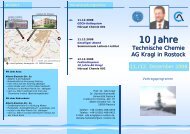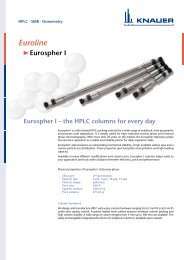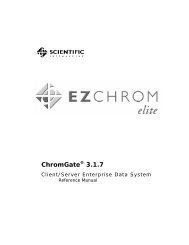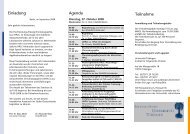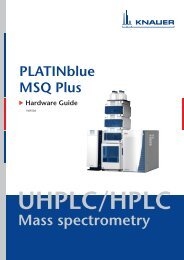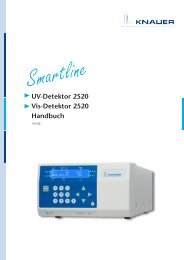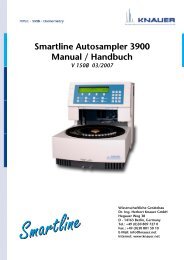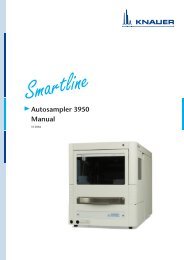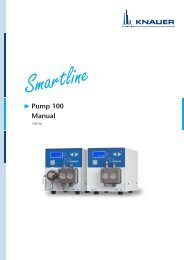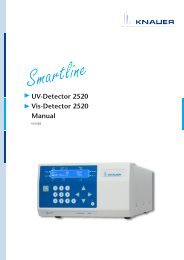ChromeGate 3.3.2 Software Manual - KNAUER Advanced Scientific ...
ChromeGate 3.3.2 Software Manual - KNAUER Advanced Scientific ...
ChromeGate 3.3.2 Software Manual - KNAUER Advanced Scientific ...
Create successful ePaper yourself
Turn your PDF publications into a flip-book with our unique Google optimized e-Paper software.
50 Setup and Control of Knauer HPLC Systems<br />
All LAN-controlled devices can be added and configured<br />
automatically using the Auto Configuration button on the<br />
configuration main window. Beside this, you can let the software<br />
search for your already connected and switched-on device from the<br />
devices configuration window. The option “Use S/N to identify the<br />
instrument” must be enabled. Click on the button to start the<br />
search for all connected LAN devices of the currently configured<br />
type. If more than one will be found, all hits will be shown in the<br />
window. Select the desired device from the shown list. The software<br />
will read-out the information as serial number and will fill it<br />
automatically into the configuration screen. For all Knauer LAN<br />
devices port 10001 is selected by default. Don’t change this setting,<br />
otherwise no communication can be established. To search for an<br />
instrument, the device must be connected, switched on and must<br />
have a valid IP address.<br />
As an option, you can enter the IP address of your device, if the<br />
option “Use S/N to identify the instrument” is disabled. Please note,<br />
that in case the device receives the IP address from a DHCP server,<br />
e.g. a router, the IP address may change if the device is switched off<br />
and switched on.<br />
Channels (available not for all detectors)<br />
For multi-wavelength detectors more than one channel can be activated.<br />
According to the selected number, the channel fields become accessible<br />
for editing. The channel name will be shown later in the method window<br />
and in the result reports. Only channels, which have been activated in the<br />
detector configuration, will be available in the method setup later for data<br />
acquisition.<br />
Serial Number<br />
If you have read-out the device via LAN, the serial number has been<br />
added automatically. Otherwise type in the serial number of the detector<br />
you are using. The serial number of network controlled detectors is used<br />
for the device identification and addressing during communication. This<br />
serial number must match the serial number of the defined pump. If not,<br />
you will get an appropriate error message if you later try to start in run.<br />
Y-Axis Units<br />
Select the type of units to be displayed on the y-axis of your<br />
chromatogram from the drop-down list. For the UV and diode array<br />
detectors the choices are AU (Absorption Units), mAU (0.001 AU) or<br />
µAU (0.000001 AU). For the RI detectors, the only choice is µRIU and for<br />
the spectrofluorometric detector the units are given as a.u. (arbitrary<br />
units).<br />
For DAD’s you have additionally also the choice ADC counts.<br />
Selecting this, the signal mode in the Instrument setup (page 102)<br />
will be indicated as ‘Intensity’ without access for changing it. This<br />
change you can perform in the configuration window only.<br />
Flow Cell<br />
Enter a description for the flow cell you are using. The description will be<br />
printed out when you print the instrument configuration.<br />
Add. Info<br />
Click the button Add. Info... to enter more detailed description of the<br />
detector.




